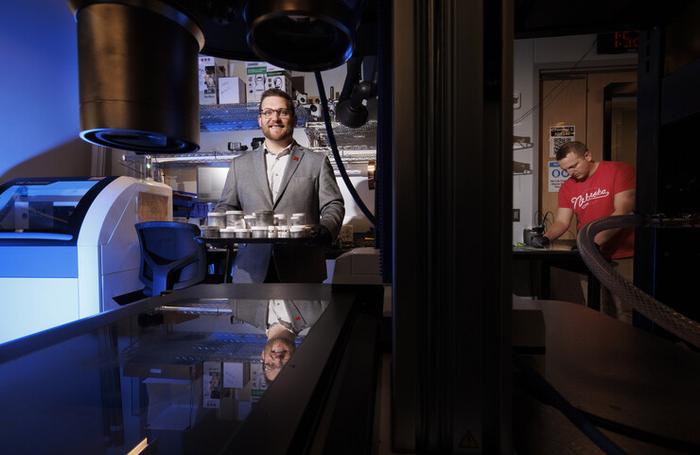Integrative Approach for Electrocatalyst and Reactor Design Enhances Electrochemical CO2 Reduction
Electrochemical carbon dioxide reduction (ECR) is rapidly gaining traction as a transformative technology that holds promise for mitigating climate change and creating valuable products from waste CO2. This process, powered by renewable energy, utilizes ECR to transform CO2 into fuels and chemicals, effectively contributing to both carbon management and energy generation. A breakthrough in this […]


Electrochemical carbon dioxide reduction (ECR) is rapidly gaining traction as a transformative technology that holds promise for mitigating climate change and creating valuable products from waste CO2. This process, powered by renewable energy, utilizes ECR to transform CO2 into fuels and chemicals, effectively contributing to both carbon management and energy generation. A breakthrough in this field comes from a thorough investigation referred to as tandem electrocatalysis, or tandem ECR (T-ECR). This methodology emphasizes the need for innovative designs of catalysts and reactor systems to maximize efficiency in CO2 conversion.
The tandem strategy emerges as the core of the new advancements in ECR, which allows for deeper CO2 reduction—targeting the production of multi-carbon products with higher economic value. However, achieving precise control over multiple reaction pathways during the conversion remains a noteworthy challenge. Without stringent regulation of reaction steps, efficiency and selectivity in the production of desired products can falter, leading to suboptimal outcomes. Therefore, this recent review delves into the fundamental principles underlying tandem catalysis, laying out potential pathways for research and innovation.
In the first section, the review addresses the microscale aspects of tandem catalysis, where the interplay between various active sites in multifunctional catalysts becomes critical. Researchers emphasize the importance of meticulous compositional engineering to enhance electron and proton transfer rates, as well as to improve the transport of reaction intermediates, ensuring heightened selectivity toward C2+ products. This elaboration into the capabilities of various materials within tandem systems highlights the necessity of innovative engineering approaches to maximize performance.
Transitioning to the mesoscale, the review spotlights tailored composite catalysts that feature spatially orchestrated reaction pathways. Such catalysts employ hydrodynamic modulation techniques through tandem electrode arrangements to optimize reaction environments. This layer of complexity not only facilitates improved kinetics but also enhances the control over reaction conditions. For instance, researchers are now focusing on the spatial distributions of active sites, orchestrating them to create ideal scenarios for mechanistic transformations. As design and synthesis techniques advance, the potential for more efficient tandem devices becomes increasingly viable.
At the macroscale, innovative configurations of cascade reactor architectures have come to the forefront. These systems integrate multiple reaction stages, providing a comprehensive framework for optimizing CO2 electrolysis at an industrial scale. Researchers are actively exploring how to combine these systems efficiently, aiming to maximize the overall efficiency of conversion processes. Such an engineered approach supports extensive adoption of CO2 utilization technologies in industry—a critical aspect in the fight against climate change.
In this revolution around tandem ECR technology, interdisciplinary methodologies are gaining prominence. The review points to the integration of operando X-ray absorption spectroscopy (XAS) and scanning tunneling microscopy (STM) as critical to the research. These advanced characterization techniques provide real-time insights into the reaction mechanisms during CO2 reduction, enabling researchers to probe into the intricacies of catalyst performance under operational conditions. This approach is invaluable for establishing a dynamic database that summarizes various reaction pathways, enhancing predictive abilities regarding reaction feasibility.
Additionally, the incorporation of machine learning-aided theoretical computations holds enormous promise for catalysis research. This innovative combination of data analytics and traditional chemistry allows for accelerated identification of high-performance catalysts, assisting scientists in overcoming the barriers to practical implementation. The advancements in computational methods are crucial for modeling complex catalytic cycles, further entrenching machine learning as a valuable ally in experimental chemistry.
Moreover, the exploration of reaction mechanisms is of paramount importance. A deeper understanding gleaned from these diverse methodologies allows researchers to create better predictions regarding catalytic behavior, improving the design of next-generation tandem reactors. These insights establish a groundwork for effective collaboration between theoretical predictions and experimental validations, a synergy that enhances the robustness of ECR technology.
In conclusion, the advances in tandem ECR technology outlined in this comprehensive review signify a milestone in the intersection of chemical engineering and sustainability. The evolving landscape of electrochemical reactions not only highlights the ingenuity of modern science but also emphasizes the urgent need for actionable strategies to combat climate change. As researchers forge ahead in exploring effective designs and optimizations for tandem catalysts and reactors, the potential for practical applications expands substantially. The reviewed findings align with pivotal trends toward heightened efficiency and performance in CO2 reduction technologies, underscoring the urgency of addressing climate challenges through innovative scientific approaches.
This discourse positions tandem ECR at the forefront of sustainable energy innovation, inviting further exploration and investment in this exciting frontier of chemical research. The detailed examinations of the methodologies employed, insights into material performance, and the overarching significance of the tandem strategy encapsulate a dynamic area that is poised for rapid advancements and impactful contributions to environmental stewardship.
Subject of Research: Tandem Electrocatalysis for CO2 Reduction
Article Title: Tandem Design on Electrocatalysts and Reactors for Electrochemical CO2 Reduction
News Publication Date: 10-Feb-2025
Web References: Chinese Journal of Catalysis Article
References: DOI: 10.1016/S1872-2067(24)60209-3
Image Credits: Chinese Journal of Catalysis
Keywords
Electrocatalysis, carbon dioxide reduction, tandem electrocatalysis, reactive systems, machine learning, advanced catalysts, energy transformation, chemical engineering.
Tags: carbon management strategiescatalysts and reactor design innovationsclimate change mitigation technologiesCO2 waste utilizationefficiency in electrochemical processeselectrochemical CO2 reduction technologyinnovative research pathways in catalysismulti-carbon product synthesisrenewable energy CO2 conversionselectivity in chemical productionsustainable energy solutionstandem electrocatalysis advancements
What's Your Reaction?

































